- Savage Blog
- Learning the Basics of Sporting Clays
Learning the Basics of Sporting Clays

When it comes to shotgun games, sporting clays is one of the most unique and challenging ones that is played today. Unlike trap and skeet shooting, sporting clays can simulate a wide variety of different types of game animals. Shooters will use sporting clays to practice hunting everything from waterfowl to rabbits, which makes it an excellent challenge for honing your shotgun skills. Learning the basics of sporting clays may be daunting at first, but it’s an enjoyable challenge that will help improve your skills all-around as a shooter and a hunter.
In this blog we’ll go over the rules and field layout for sporting clays, what gear and equipment you will need, the different types of shotguns most commonly used for sporting clays, ammunition and choke tubes, and shooting tips. Let’s dive in and learn more about the basics of sporting clays!
Rules and Field Layout
Field Layout
Sporting clays’ most unique aspect is that no two fields are laid out the same way. In trapshooting and skeet shooting, the course of fire is the same from field to field no matter where you are shooting. In sporting clays, each field is set up differently and the course of fire can be different each time you shoot the course. Sporting clays is often referred to as “golf with a shotgun”, since a sporting clays course is similar to a golf course in being unique and different with stations laid out over the terrain.
While each field is different, most fields will follow a standard layout of having 10 to 15 stations. At these stations, there will be one or two trap throwers, which will throw the targets in the same way each time. Targets may be thrown on a basic flightpath, such as in front of the shooter, or in more unique ways like on the ground (called a rabbit), or from overhead and behind the shooter. Throwers may be in sight of the shooter, or they may be hidden to obscure where the target is coming from. Shooters may shoot anywhere from 2 to 6 or more targets at each station, depending on how the course is laid out. Depending on the field, you may shoot anywhere from 25 to 100 targets in the course of fire. The unique field layouts and different courses of fire are what makes sporting clays challenging, but also fun and a unique challenge each time you go out to shoot!
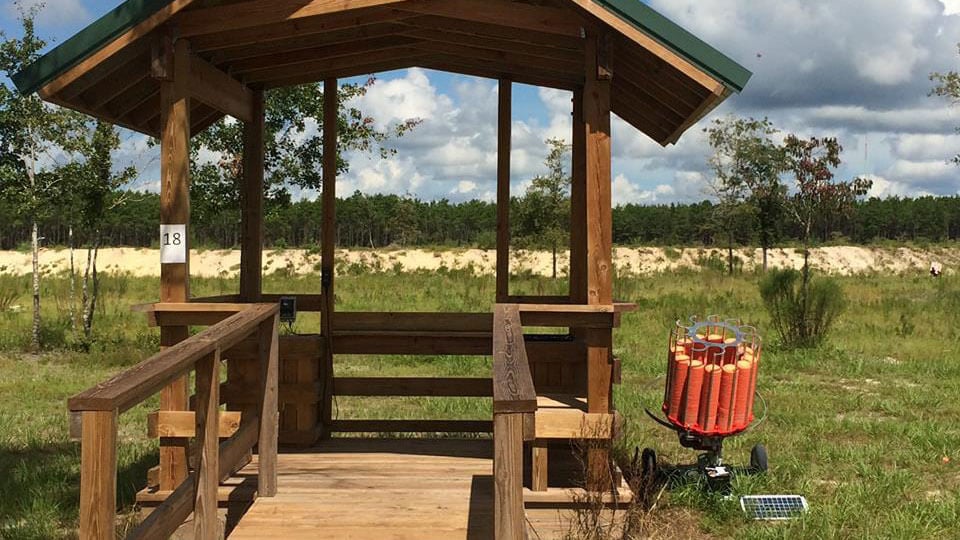
Rules
Like the course of fire, the rules of sporting clays are unique and a bit different from trap or skeet. Here are some of the rules you’ll need to know as you learn the basics of sporting clays:
Shooters can be assembled into a squad of three to six shooters, depending on the course.
Shooters will shoot each station in the same shooting order.
Targets are thrown at each station in pairs.
Multiple pairs are often shot at each station, especially on shorter courses or courses that require more rounds.
Targets can be thrown in three different ways; a true pair, following pair, and report pair
True pair: Both targets are thrown at the same time.
Following pair: The first target is thrown when the shooter calls for it, while the second target is thrown following the first target at the official’s discretion.
Report pair: The first target is thrown when called for by the shooter. The second target is thrown on the report (shot) of the shotgun.
Multiple target sizes may be thrown, ranging from “mini” targets to “standard” targets
Shooters must keep themselves and their shotgun within the shooting frame while engaging targets.

Sporting Clays Shooting Equipment
Like other shotgun sports, safety equipment is a must for sporting clays. Shooters will need safety glasses and hearing protection, such as earplugs or muffs. Most shotgun shooters will prefer earplugs or slim earmuffs to help them get their head down on their stock so they can look down the barrel properly. It is also a good idea to have a trap bag or shooting vest when you are shooting sporting clays in order to hold your ammunition and extra choke tubes. Some sporting clays courses will offer golf cart rentals for you to drive around the course, rather than walking the entire way. This is especially helpful if a course has difficult terrain to walk on. If you plan to walk along a sporting clays course, make sure you have a good pair of boots handy. Better yet, bring out your boots you plan to hunt with in order to help break them in and get comfortable walking in the field with them!
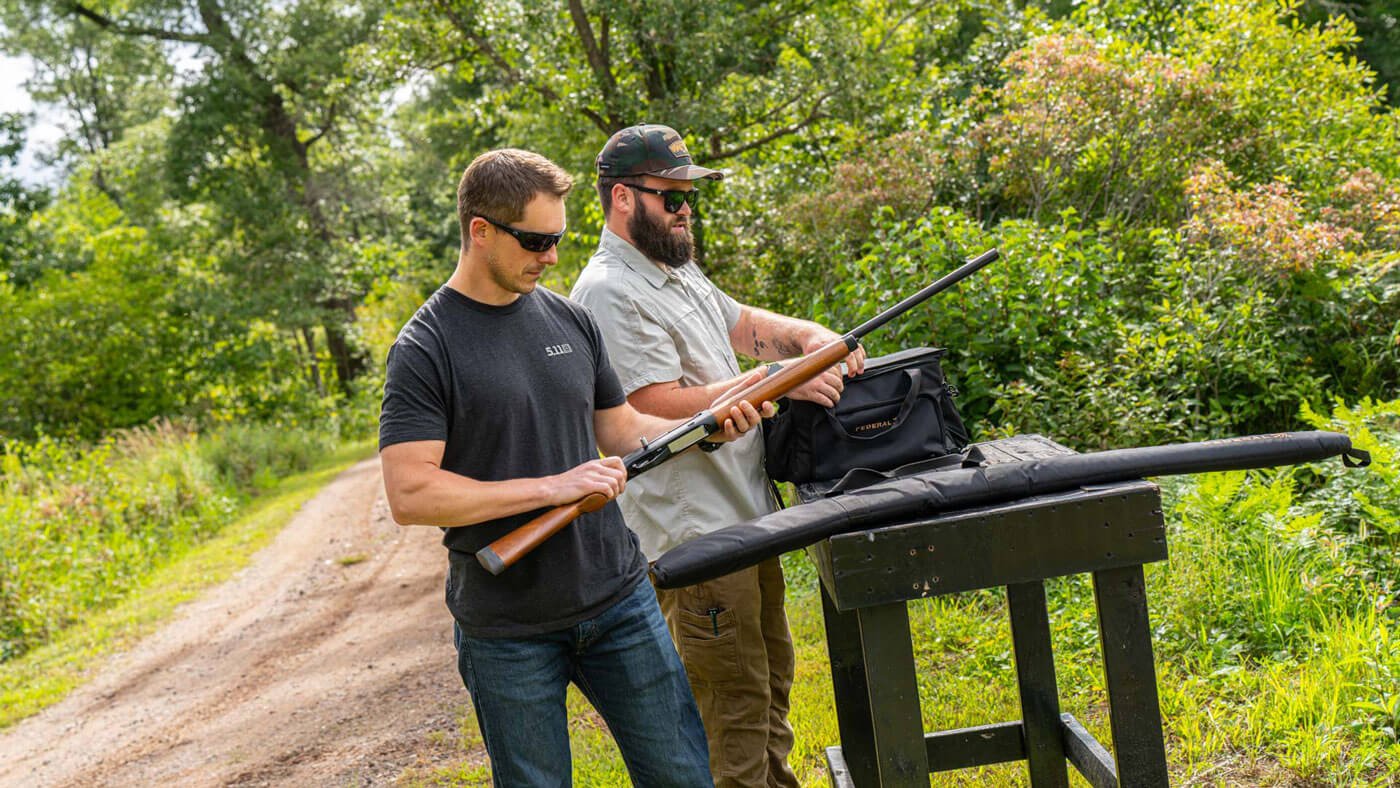
Shotgun Selection
Selecting the right shotgun can make all the difference when you are learning the basics of sporting clays. It is most important to look for a shotgun that is easy to maneuver and swing and fits you well so you can be comfortable shooting. You will also want a shotgun that holds at least 2 shells, as you will be shooting pairs each time you shoot on a sporting clays station. Let’s look at some of the most popular shotgun actions and see how they each can work for use in sporting clays.
Pump-Action
Pump-action shotguns are good for new and novice shooters as they are common, relatively inexpensive, and easy to learn and operate. The shell is loaded and unloaded by pumping the slide of the shotgun, and this is entirely controlled by the shooter. Pump action shotguns can have varying effectiveness in sporting clays. On stations where targets are at a longer range or slower moving, a pump action can certainly be as effective as other shotguns. On stages where targets are closer and moving faster, a pump action may be too slow to operate to get an effective follow-up shot. To be the most effective on sporting clays, we would recommend avoiding pump action shotguns.
Semi-Automatic
Semi-automatic shotguns operate like other semi-automatic firearms, where the shotshell is ejected automatically and a new shell is loaded after each shot, if the magazine is loaded. Semi-automatics are easy to learn and easy to operate for sporting clays. Semi-automatics are also typically lighter in recoil due to their gas or inertia driven recoil systems that help bleed off excess pressure. The Savage Renegauge is an excellent choice for sporting clays shooters who are looking for a semi-automatic shotgun that is reliable, easy shooting, and adjustable to nearly every shooter. For sporting clays shooters who are looking for a budget semi-automatic shotgun that will be a workhorse on the skeet field and the hunting field, the Stevens 560 is also a great option.

Break-Action
Break-action shotguns are fairly popular with shotgun shooters. Most break-action shotguns come as double-barrel shotguns, with two barrels either stacked on top of each other or side by side. This allows the shooter to have two shells loaded simultaneously, allowing for a rapid follow-up shot. Break-action shotguns are arguably the most popular shotguns that are used in sporting clays today, mainly due to their popular use in upland hunting and other bird hunting scenarios that sporting clays mimic. They are perfect for having two shells ready for your targets, as well as being lightweight, ergonomic, and well balanced when swinging. Savage offers several different break-action shotguns in the Stevens 555 shotgun line, including a 555 Compact model for youth and smaller shooters, and a 555 Sporting model with 30 inch, ported barrels and an adjustable cheek comb that is ideal for sporting clays.
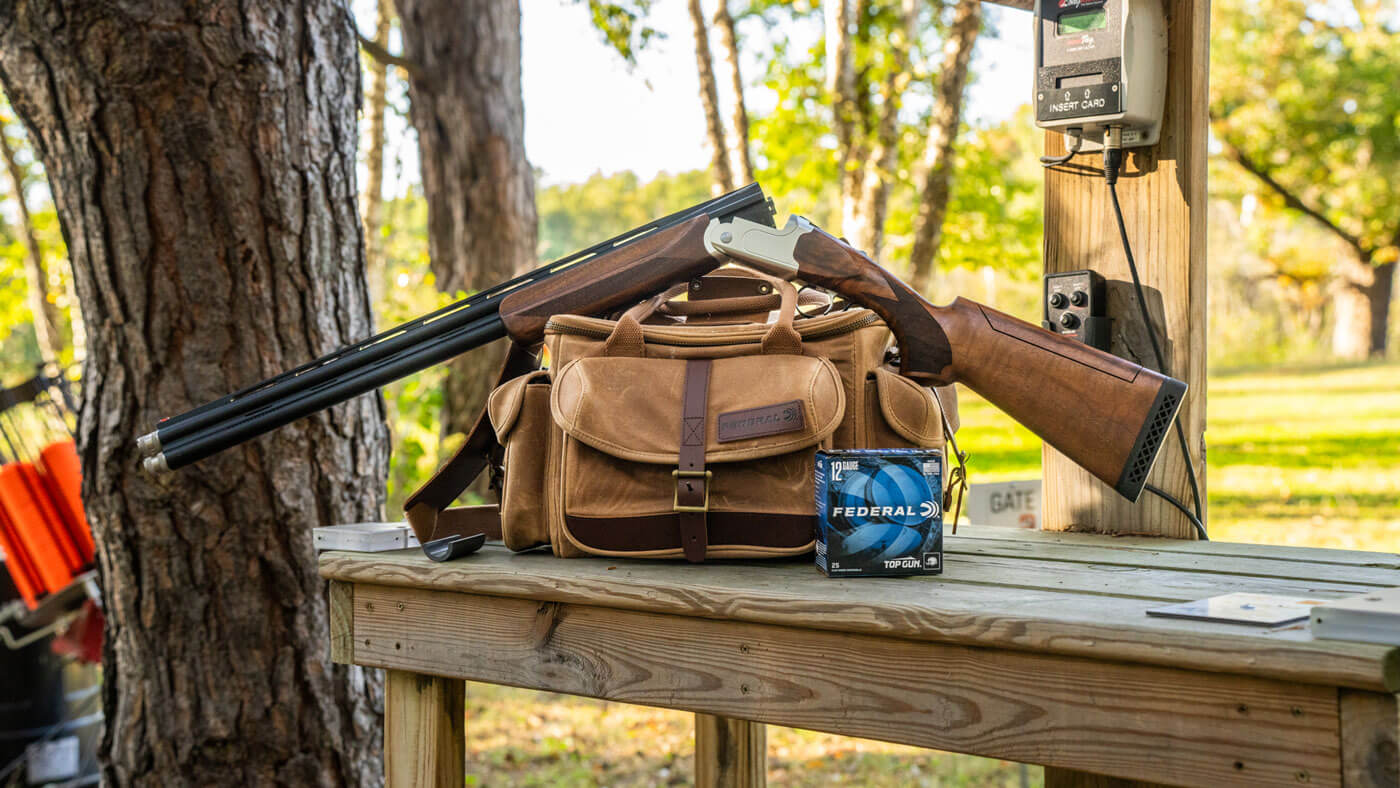
Ammunition and Choke Tubes
Like other shotgun sports, sporting clays requires lower power shotgun shells. They are typically referred to as “game loads”, “target loads”, “field loads”, or something similar. These loads are typically lead shot, and will usually have a picture of a clay target or a small game animal such as a dove or rabbit on the box. They will also usually say “Game Load”, “Field Load”, “Target Load”, or something similar on the box. Most target loads will have specifications similar to the following:
⅞ to 1 ⅛ oz. of shot
2 ¾ inch shell length
#7 ½ or #8 shot size
1150 to 1350 fps
If you find ammunition with similar specifications to those that are outlined above, then it will be great to use for sporting clays!
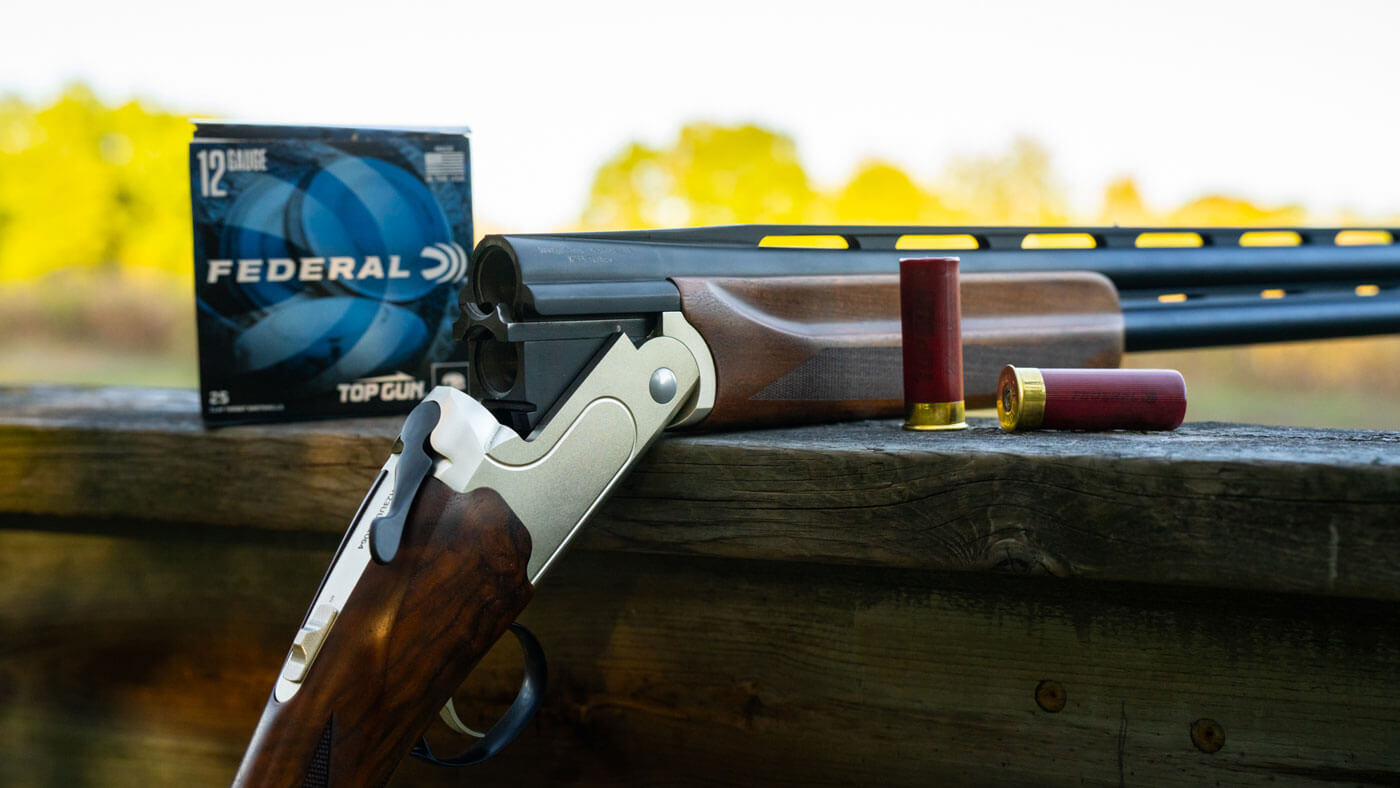
Due to the uniqueness of each station and scenario in sporting clays, there is rarely a one-size fits all approach to selecting a choke tube. One reason that over/under break-action shotguns are so popular in sporting clays is that it allows the shooter to take advantage of two different barrels that can have two different choke tubes in them. The shooter can opt to have an improved cylinder choke with a more open pattern for closer targets, while they can follow up on targets further away with a modified or full choke in the other barrel for a tighter pattern at longer range. If you don’t know the course of fire for the sporting clays range you are shooting at, or you are using a shotgun with one barrel, a good middle ground is a modified choke tube. A modified choke tube may require you to be more precise at closer ranges with a less forgiving pattern than an improved cylinder choke, but it is able to break targets at longer ranges with a better pattern while still being effective at close range. Check out this blog to learn more about choke tubes and when to pick the right one!
Shooting Tips
Learning the basics of sporting clays is about more than the rules and proper equipment. Learning eye dominance, proper shooting form and stance, and proper shooting technique are also important to know as you are starting out. Here are some tips to keep in mind as you get started with the basics of sporting clays:
Eye dominance
Eye dominance is one of the fundamental basics of sporting clays that you should learn when you are first starting out. Shooting sporting clays requires the shooter to have both eyes open. This will help you have a wider field of vision, which is helpful for acquiring targets faster, especially when they are coming from behind or beside you in your peripheral vision. Your dominant eye is the eye that will naturally “take over” and direct your aiming as you focus on the target. This is the eye that should be looking down the barrel when you are aiming the shotgun. If you don’t know which eye is your dominant eye, check out this blog post on determining eye dominance.
Stance and technique
In sporting clays, the shooter stands within a frame that limits how far they can swing their shotgun on the target. Your stance when shooting sporting clays should be essentially the same as your stance would be in trap shooting. You should square your body forward, keep your feet shoulder width apart, with your leading foot (left foot for right-handed shooters and right foot for left-handed shooters) a few inches in front of your back foot. Bend your knees slightly, and lean forward slightly at the waist to help absorb recoil. Mounting your shotgun before calling for the target is a personal preference when it comes to sporting clays. Some shooters prefer to pre-mount their shotgun, while others prefer to have their shotgun at a “low ready” position and then mount the shotgun as they see the target. Whichever method you prefer, make sure you practice it plenty and stick to it for the best results!
Other Tips
While you’re watching a sporting clays shoot from the sideline, the targets will appear to be moving very fast and difficult to shoot. This is especially true if you’re a beginner learning the basics of sporting clays, and are unfamiliar with shooting these types of targets. When you get up to the station to shoot, make sure you go slow and smooth through your course of fire! Rushing too much can lead to misses, and you often have more time to shoot the target than you think you do.
Make sure you focus on the target, and not the bead on the front of your barrel. If you try to aim your shotgun like a rifle, you will often stop moving and end up way behind the target when you shoot. Focus on the leading edge of the target, swing out in front of the target, and pull the trigger to get a hit on the target. Make sure you keep your head on the stock and look for the next target, especially if it is a following or report pair where the targets are thrown separately.
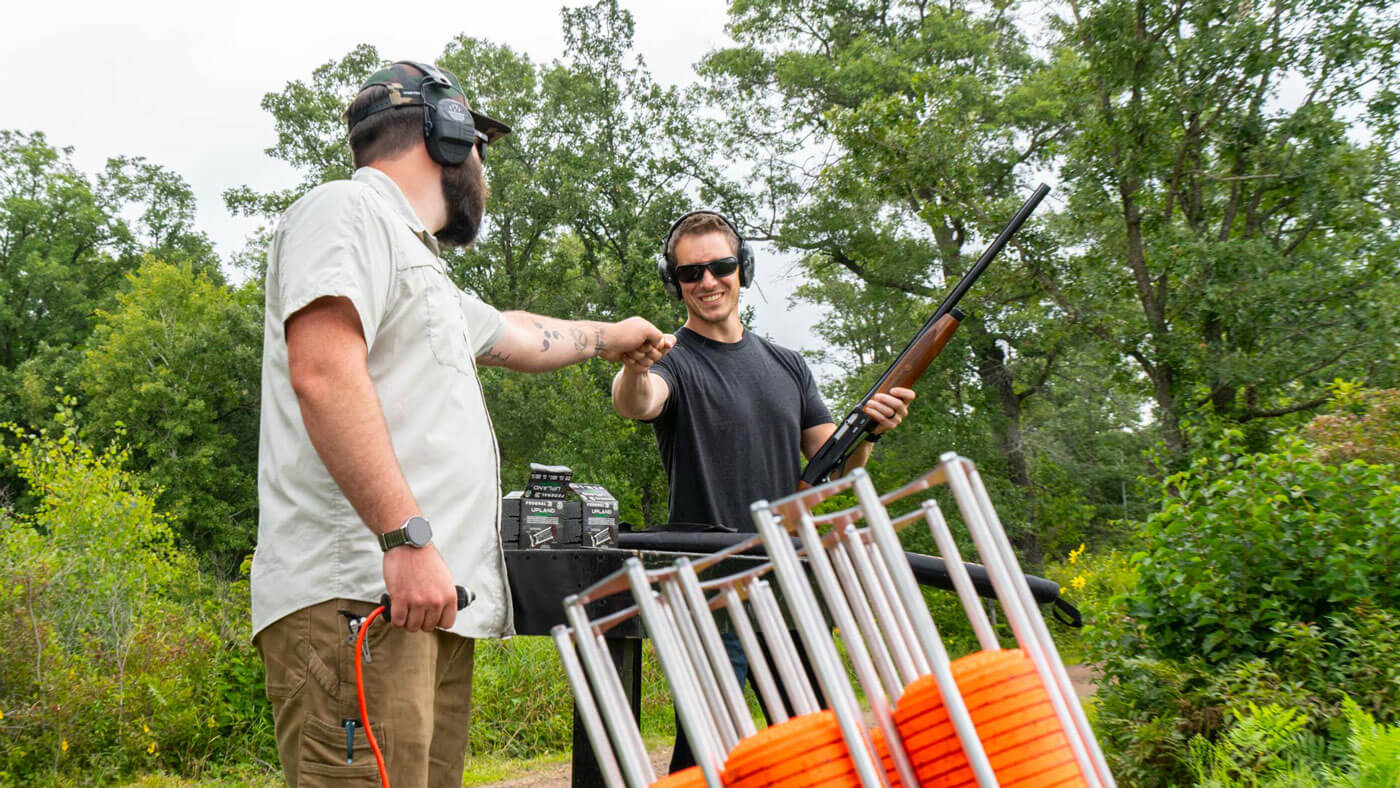
By learning the basics of sporting clays, you can set yourself up for success in the field this fall. It is also a great way to improve your shotgun skills in general, and to help you get better at other shotgun games like trap and skeet. Plus, it’s just downright fun! If you’re looking for a way to hone your shotgun skills, check out your local sporting clays range! You may just find yourself with a new favorite shotgun game, and more birds in your bag this fall.

